 | | | Switch to: Europe, USA, New Zealand, Antarctica Credit: NOAA/Ovation  Planetary K-index Planetary K-index
Now: Kp= 2 quiet
24-hr max: Kp= 3 quiet
explanation | more data
Interplanetary Mag. Field
Btotal: 7.6 nT
Bz: -3.0 nT south
more data: ACE, DSCOVR
Updated: Today at 2345 UT  Coronal Holes: 28 Nov 21 Coronal Holes: 28 Nov 21 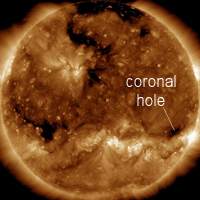
A minor stream of solar wind flowing from this coronal hole could reach Earth on Nov. 28. Credit: SDO/AIA  Noctilucent Clouds The northern hemisphere season for noctilucent clouds appears to be over. NASA's AIM spacecraft detected no evidence of NLCs around the north pole on Aug. 29th. Switch view: Europe, USA, Asia, Polar Updated at: Noctilucent Clouds The northern hemisphere season for noctilucent clouds appears to be over. NASA's AIM spacecraft detected no evidence of NLCs around the north pole on Aug. 29th. Switch view: Europe, USA, Asia, Polar Updated at:  SPACE WEATHER
NOAA Forecasts | | Updated at: 2021 Nov 28 2200 UTC FLARE | 0-24 hr | 24-48 hr | CLASS M | 05 % | 05 % | CLASS X | 01 % | 01 % |  Geomagnetic Storms: Geomagnetic Storms:
Probabilities for significant disturbances in Earth's magnetic field are given for three activity levels: active, minor storm, severe storm Updated at: 2021 Nov 28 2200 UTC Mid-latitudes | 0-24 hr | 24-48 hr | ACTIVE | 15 % | 10 % | MINOR | 05 % | 01 % | SEVERE | 01 % | 01 % | High latitudes | 0-24 hr | 24-48 hr | ACTIVE | 15 % | 20 % | MINOR | 25 % | 20 % | SEVERE | 25 % | 10 % | | | |  | | | | | | | | | | | Lights Over Lapland has a full catalogue of exciting adventures in Abisko National Park, Sweden! Check out our daytime and evening activities and book your adventure! | | | WEAK CME IMPACT: As predicted, a CME hit Earth's magnetic field during the late hours of Nov. 27th (approx. 23:30 UT). The weak impact did not cause a geomagnetic storm--not even a minor one. A brief outburst of auroras over Alaska might have been related to the CME's arrival. Aurora alerts: SMS Text SOLAR ORBITER SURVIVES RISKY FLYBY: Yesterday, Nov. 27th, Europe's Solar Orbiter spacecraft buzzed the nightside of Earth just 470 km above the Atlantic Ocean. When the spacecraft emerged from our planet's shadow, Arizona astronomer Scott Tucker photographed it racing through the constellation Aries. Click to set the scene in motion: 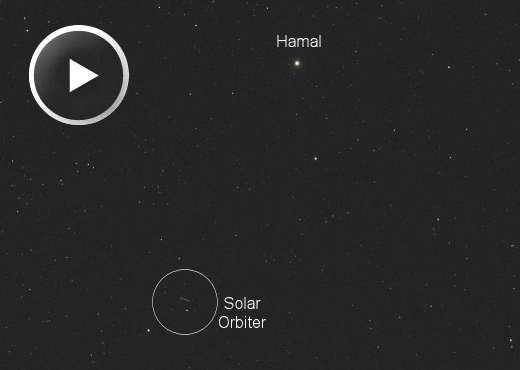
"In the movie, the total timelapse is about 3 minutes with individual exposures of 2 seconds. The field of view is 10 degrees wide," explains Tucker. "There is also a random, slower moving satellite passing through the same field in the upper right." Shortly after Tucker recorded this movie, the European Space Agency reported "Solar Orbiter is out of the space debris danger zone following its close Earth flyby and on its way to the next close pass of the sun next year." The orbit-bending maneuver sent Solar Orbiter hurtling toward the sun. Next year, it will photograph our star from point-blank range inside the orbit of Mercury. Incredibly, that is *not* the riskiest part of Solar Orbiter's mission. Passing close to Earth where space is filled with debris worried mission controllers even more. Realtime Space Weather Photo Gallery
Free: Spaceweather.com Newsletter THE DAYTIME MOON: Some people think the Moon can only be seen at night. "In fact," says Taiwanese phtographer Meiying Lee, "if you look up at the sky, you will find that not only can the Moon be seen during the day, but also that it is very charming." This combined photo shows daytime Moons of all phases photographed by Lee over the past 5 years: 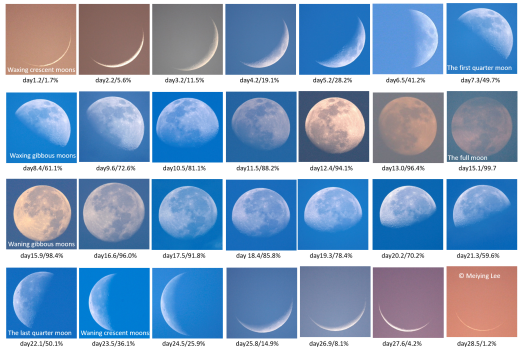
"A special thing about this photo is that you can see the relationship between the Moon and the sky," says Lee. "Crescent Moons are near the sun, so they can only be observed during sunset and sunrise; the sky around them is pink or off-white. Blue sky surrounds half Moons and gibbous Moons, which are relatively easy to find in broad daylight." "The full Moon during the day is the most difficult to observe," says Lee. "In the summer, daytime is longer and there is a chance to observe it. But the weather in the summer afternoon is often bad in Taiwan, so in the past five years I could barely get a single picture of the full Moon on a misty day--the last one in the second row." Realtime Aurora Photo Gallery
Free: Spaceweather.com Newsletter GIFTS FROM THE EDGE OF SPACE: Christmas is coming. Are you looking for a far-out gift? Check out the Earth to Sky Store. It's filled with unique items that have flown to the edge of space onboard cosmic ray research balloons.

Carried aloft by giant helium balloons, these unique gifts have flown above 99.7% of Earth's atmosphere, experiencing space-like blasts of cosmic rays, extreme cold, and a wild ride parachuting back to Earth after the balloon explodes. Even Amazon doesn't carry items this far out. Don't forget to enter coupon code "BLACKPEARL" at checkout for a 15% Extended Black Friday discount. Far Out Gifts: Earth to Sky Store
All sales support hands-on STEM education
Every night, a network of NASA all-sky cameras scans the skies above the United States for meteoritic fireballs. Automated software maintained by NASA's Meteoroid Environment Office calculates their orbits, velocity, penetration depth in Earth's atmosphere and many other characteristics. Daily results are presented here on Spaceweather.com. On Nov 28, 2021, the network reported 17 fireballs.
(17 sporadics) 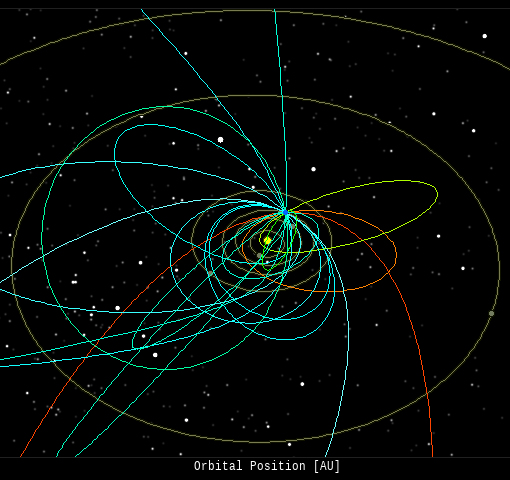 In this diagram of the inner solar system, all of the fireball orbits intersect at a single point--Earth. The orbits are color-coded by velocity, from slow (red) to fast (blue). [Larger image] [movies] Potentially Hazardous Asteroids ( PHAs) are space rocks larger than approximately 100m that can come closer to Earth than 0.05 AU. None of the known PHAs is on a collision course with our planet, although astronomers are finding new ones all the time. On November 28, 2021 there were 2241 potentially hazardous asteroids.
 | Recent & Upcoming Earth-asteroid encounters: | Asteroid | Date(UT) | Miss Distance | Velocity (km/s) | Diameter (m) | | 2021 WT | 2021-Nov-23 | 1.4 LD | 16.4 | 35 | | 2021 VL16 | 2021-Nov-23 | 14.3 LD | 8.4 | 19 | | 2021 WW1 | 2021-Nov-24 | 9.2 LD | 7.9 | 24 | | 2021 WC | 2021-Nov-24 | 14.3 LD | 7 | 52 | | 2021 WG | 2021-Nov-24 | 2.3 LD | 6.1 | 6 | | 2014 WF201 | 2021-Nov-24 | 13.2 LD | 5.5 | 27 | | 2021 VR4 | 2021-Nov-25 | 2.1 LD | 7.7 | 19 | | 2009 WB105 | 2021-Nov-25 | 15.1 LD | 18.9 | 71 | | 2021 VQ27 | 2021-Nov-25 | 2.7 LD | 10.2 | 14 | | 2021 VF11 | 2021-Nov-25 | 18.6 LD | 1.3 | 14 | | 2019 BB5 | 2021-Nov-25 | 18.8 LD | 8.3 | 16 | | 2021 WA1 | 2021-Nov-26 | 0.8 LD | 13.9 | 11 | | 2021 VM | 2021-Nov-27 | 9.4 LD | 8.9 | 30 | | 2021 WC1 | 2021-Nov-28 | 0.5 LD | 11.7 | 7 | | 2021 VO12 | 2021-Nov-28 | 7.3 LD | 13.5 | 52 | | 1994 WR12 | 2021-Nov-29 | 16.1 LD | 8.8 | 123 | | 2021 WK1 | 2021-Nov-30 | 2.7 LD | 8 | 20 | | 2021 WJ1 | 2021-Nov-30 | 4.5 LD | 10.2 | 13 | | 2021 WR | 2021-Dec-01 | 6.8 LD | 8.8 | 29 | | 2021 UP4 | 2021-Dec-04 | 13.9 LD | 8.3 | 53 | | 2021 VX7 | 2021-Dec-06 | 14.8 LD | 6.1 | 41 | | 2021 WE1 | 2021-Dec-06 | 5.6 LD | 9 | 23 | | 2021 WV1 | 2021-Dec-11 | 1.5 LD | 3 | 7 | | 4660 | 2021-Dec-11 | 10.3 LD | 6.6 | 759 | | 2021 WQ1 | 2021-Dec-12 | 7.8 LD | 8.8 | 27 | | 2021 VW27 | 2021-Dec-13 | 18.7 LD | 8.4 | 42 | | 2019 XQ1 | 2021-Dec-13 | 14.1 LD | 9.1 | 30 | | 2021 VT6 | 2021-Dec-14 | 7.7 LD | 6.9 | 51 | | 2004 YC | 2021-Dec-15 | 18.4 LD | 8.1 | 27 | | 163899 | 2021-Dec-17 | 14.2 LD | 5.6 | 1093 | | 2021 LX3 | 2021-Dec-18 | 19.7 LD | 6.5 | 124 | | 2016 YY10 | 2021-Dec-21 | 11.3 LD | 9.2 | 23 | | 2017 XQ60 | 2021-Dec-21 | 13.7 LD | 15.7 | 47 | | 2016 TR54 | 2021-Dec-24 | 16.9 LD | 15.5 | 135 | | 2018 AH | 2021-Dec-27 | 11.9 LD | 12.7 | 112 | | 2017 AE3 | 2021-Dec-29 | 9.3 LD | 19.1 | 155 | | 2014 YE15 | 2022-Jan-06 | 19.3 LD | 6.4 | 8 | | 2020 AP1 | 2022-Jan-07 | 4.6 LD | 5.7 | 4 | | 2013 YD48 | 2022-Jan-11 | 14.6 LD | 14.8 | 107 | | 2021 BA | 2022-Jan-18 | 9.8 LD | 9.1 | 22 | | 7482 | 2022-Jan-18 | 5.2 LD | 19.6 | 1732 | | 2018 PN22 | 2022-Jan-21 | 11.4 LD | 2.7 | 11 | | 2017 XC62 | 2022-Jan-24 | 18.7 LD | 4.3 | 112 | Notes: LD means "Lunar Distance." 1 LD = 384,401 km, the distance between Earth and the Moon. 1 LD also equals 0.00256 AU. MAG is the visual magnitude of the asteroid on the date of closest approach. | | Cosmic Rays in the Atmosphere | SPACE WEATHER BALLOON DATA: Almost once a week, Spaceweather.com and the students of Earth to Sky Calculus fly space weather balloons to the stratosphere over California. These balloons are equipped with sensors that detect secondary cosmic rays, a form of radiation from space that can penetrate all the way down to Earth's surface. Our monitoring program has been underway without interruption for 6 years, resulting in a unique dataset of in situ atmospheric measurements. Latest results: Our most recent flight on June 25, 2021, confirms a trend of decreasing cosmic radiation: 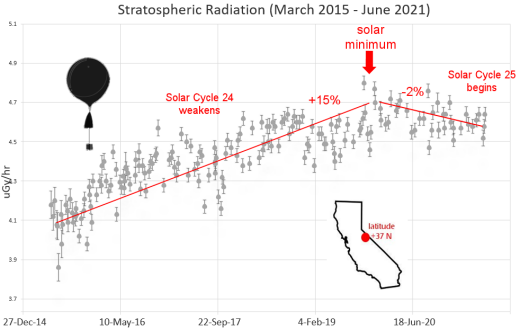
Cosmic ray dose rates peaked in late 2019, and have been slowly declining ever since. This makes perfect sense. Solar Minimum was in late 2019. During Solar Minimum the sun's magnetic field weakens, allowing more cosmic rays into the solar system. We expect dose rate to be highest at that time. Now that Solar Minimum has passed, the sun is waking up again. Solar magnetic fields are strengthening, providing a stiffer barrier to cosmic rays trying to enter the solar system. The decline of cosmic radiation above California is a sign that new Solar Cycle 25 is gaining strength. .Who cares? Cosmic rays are a surprisingly "down to Earth" form of space weather. They can seed clouds, trigger lightning, and penetrate commercial airplanes. According to a study from the Harvard T.H. Chan school of public health, crews of aircraft have higher rates of cancer than the general population. The researchers listed cosmic rays, irregular sleep habits, and chemical contaminants as leading risk factors. Somewhat more controversial studies (#1, #2, #3, #4) llink cosmic rays with cardiac arrhythmias and sudden cardiac death. En route to the stratosphere, our sensors also pass through aviation altitudes: 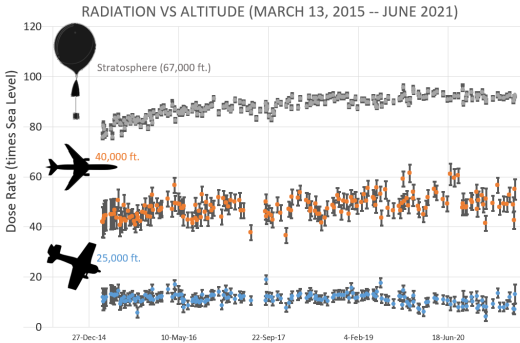
In this plot, dose rates are expessed as multiples of sea level. For instance, we see that boarding a plane that flies at 25,000 feet exposes passengers to dose rates ~10x higher than sea level. At 40,000 feet, the multiplier is closer to 50x. The higher you fly, the more radiation you will absorb. Technical notes: The radiation sensors onboard our helium balloons detect X-rays and gamma-rays in the energy range 10 keV to 20 MeV. These energies span the range of medical X-ray machines and airport security scanners. Data points in the first graph ("Stratospheric Radiation") correspond to the peak of the Regener-Pfotzer maximum, which lies about 67,000 feet above central California. When cosmic rays crash into Earth's atmosphere, they produce a spray of secondary particles that is most intense at the entrance to the stratosphere. Physicists Eric Regener and Georg Pfotzer discovered the maximum using balloons in the 1930s and it is what we are measuring today. | | The official U.S. government space weather bureau | | | The first place to look for information about sundogs, pillars, rainbows and related phenomena. | | | Researchers call it a "Hubble for the sun." SDO is the most advanced solar observatory ever. | | | 3D views of the sun from NASA's Solar and Terrestrial Relations Observatory | | | Realtime and archival images of the Sun from SOHO. | | | information about sunspots based on the latest NOAA/USAF Active Region Summary | | | from the NOAA Space Environment Center | | | fun to read, but should be taken with a grain of salt! Forecasts looking ahead more than a few days are often wrong. | | | from the NOAA Space Environment Center | | | the underlying science of space weather |  | Going above and beyond to provide the best homes listings in the Comox real estate market to keep you up to date and informed |  | Looking for sports betting companies not registered on GamStop? CasinoGap has presented a list of sites not on GamStop available for UK players. Check and bet online! Would you like to bet at sites not using GamStop? Look at a list of NonStopCasino sites for online betting that aren't on GamStop. Top-rated bookmakers ever! |  | One of the most popular casino games is the Book Of Dead Slot based on ancient Egyptian text, you can find all the casinos with spins at bookofdeadslotsites.com. |  | When looking for casinos to play online when the weather is bad, you can try luotettavat nettikasinot for Finnish games. If you are not from Finland you can try the Swedish page Svenska casino online to find suitable games, check out svenskacasinoonline.net. Always check your local laws before playing with real money. |  | Finns rank fourth among the world’s biggest gamblers. More on Finnish online casinos you can find at Nettikasino site. |  | To find reviews of new online casino sites in the UK try The Casino DB where there are hundreds of online casino reviews complete with bonuses and ratings. Alternatively, Online-Casinos.xyz is another massive directory of online casinos listing sites for the UK and Worldwide. Casinos that offer Rupees for bonuses are very generous to Indian players. Find the best online casinos in India at AllCasinos.in Looking for a new online casino? Try Casimpo the new site dedicated to making online casino simple, or check out the new Avenger Slots Casino and Ace Online Casino with over 500 online slots and casino games. | | | These links help Spaceweather.com stay online. Thank you to our supporters! | | | | | | | | |  | |  |   | ©2021 Spaceweather.com. All rights reserved. This site is penned daily by Dr. Tony Phillips. | |

